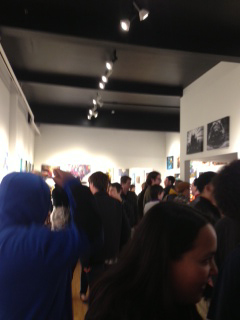On March 2, 2013 Jason Warnke had his Curatorial Debut exhibiting 140 video game artists (60 at the gallery and 80 included online) at Gauntlet Gallery in San Francisco.
The following interview was held at Zero Zero Restaurant in San Francisco on March 8th, 2013.
Lin Evola: Jason what inspired you to curate an exhibition of Video Game art? Why Mega Man?
Jason Warnke: Mega Man was a massive influence in my early video game days. He stood as a hero and the non-linear gameplay mixed with the ability to acquire power from the obstacles (or Robot Masters) was so incredibly aspirational. Also the characters themselves are incredibly lighthearted while remaining interesting. The main hero is an android built to assist Doctor Light, but when Doctor Wily turns his creations into weapons of destruction, Mega Man is sent to defeat him.
LE: Where do you see the future of video game art?
A) visually
B) technically

JW: Haha. This is a very complicated question with no true answer. I see video game art going in every direction... but the good art that drives the medium forward is where it sticks, where people latch onto and can appreciate it. Take Guild Wars 2 for example. They have spent years making the game feel like a painting and it has paid off. The game is gorgeous and the fans love it.
LE: Jason, what is video game art?
JW: "Video game art" means a lot of things. There is the technical aspect of building art for games, both as concept art in a traditional form and digital art assets that the game code uses. But to me Video Game Art is world building. Game artists have to not only make art, they have to make a cohesive world for people to explore.
LE: Why Mega Man?
JW: Mega Man was one of the first games that I and most of my friends played. When Mega Man overcome the obstacles in his way, the Robot Masters, he gains the power of the boss enemy. With that new empowerment, you are able to defeat the next boss quicker, more efficient.
LE: It is the Hero's Journey (see Joseph Campbell).
Do you see this medium (video games) being a direction of fine art?
JW: People appreciate what they appreciate. Fine art is a gorgeous and incredible art form, and so is digital art. In fact digital art is nothing without traditional art, it is an evolution of art with the incredibly strong emotional attachments video game players have with these games, I see video game art as being a widely accepted art medium that allows artists and writers to tell the story they want to tell.
Robot Masters (bosses) in Mega Man started off as benign helper robots that served a specific benifitial purpose like regulating the voltage of nuclear power plants or operate an incinerator at a junk yard. But after the treachery of the Villanous Doctor Wily, each robot master were converted to villains. This transitory use of imagery is interesting. Some of the artists in the show captured these android characters at different points in their game life.
LE: This is similar to Rembrandt, Leonardo Da Vinci, Lynn Hershman - artists that capture portraits of themselves at various points in their lives.
Jason, what did you look for in the artists that you exhibited?
JW: Talent & Style. Passion. Love for the Beloved Blue Bomber (Mega Man).
Most of the art was digitally printed. This led to the same accessibility that video games can have. We can play video games wherever and whenever we choose and we are printing art to purchase and place at any price and size that we prefer. Access is important.
For the exhibition, all art had to be 3x4, which is significant to the Mega Man series because the original game menu Level Selection (or Boss selection) portrayed each of the bosses with a 3x4 inch landscape portrait of the character.
LE: What is next for the exhibition?
The Comic Book Museum has asked for the exhibition to go there next, so check back for more details about a show in the summer.
JW: I am also looking forward to conceiving what the next video game exhibition will have as a theme.
LE: As Co-Founder of Wormhole Games, how do you see continuing as a curator fitting into your role as Game Designer?

JW:Wormhole Games: We want to make bad-ass games that relate back to the core of video games.
It is the next generation of artists who combine what was intimate for them as they now portray what it was that they experienced and use the skill base and technology that is their inheritance. If they want to look up any artist in the world at any time of history, they can. It will be interesting to see how art morphs...it always does. Bravo to this new breed of artists in a world where drawers, painters, sculptures find their way in the world outside what was known before they were born.
As a professional Artist, I am eager to see.